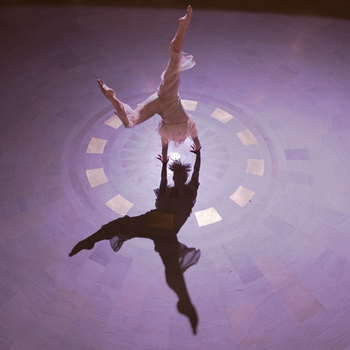
Come June, you can often count on Ann Arbor Dance Works, the resident professional company of the University of Michigan dance department, to set up shop somewhere swell. And unexpected.
One year, it was the Arb. Last year, it was downtown Ann Arbor, where the dancers romped through commercial spaces, cavorted in alleys and courtyards and signaled each other along the railroad tracks. We took our folding stools along, and had a blast.
This year, the company moves back on campus, but not to your regulation theater or studio. For “Within/Beyond,” which the company presents Saturday and Sunday evening, AADW repairs to the U-M Museum of Natural History, which is collaborating on the concert.
The museum is more than just an unusual site for the four dances on the program, which come from three faculty choreographers—Jessica Fogel, Peter Sparling and Robin Wilson—and New York guest Edisa Weeks. The dances, all premieres featuring students and faculty, take their cues from the sciences, finding inspiration in research here and elsewhere. Weeks, for example, plans a dance based on the spiraling structures of DNA. She arrived last week to make the work with the student cast.
When Fogel, who is AADW’s artistic director, set out to plan this June’s concert,“ I was looking for a beautiful or interesting site,” she said. The rotunda of the natural history museum fit that bill; the audience will sit in the round on two levels; the dancers have a 28-foot diameter space in which to move—but not to leap much, given the hard, travertine floor.
“We’re keeping it pretty grounded,” Fogel said.
But that’s not keeping the dancers, or the choreographers, earthbound.
PREVIEW
Ann Arbor Dance Works
- Who: Local dance company.
- What: “Within/Beyond” - dances inspired by the sciences.
- Where: The U-M Museum of Natural History, 1109 Geddes Ave., on the U-M Central Campus (northwest corner, intersection of Washtenaw and Geddes).
- When: Saturday and Sunday, June 8 and 9, 8 p.m.
- How much: $10. Tickets available from the Michigan Union Ticket Office in the Michigan Union, 734-763-8587, and online at mutotix.com. Also at the door, but seating is limited and advance purchase is recommended.
As Fogel gazes up, Sparling looks within, with a serio-comic dance called “How Autophagy Works.” What’s autophagy? It’s the cellular process of “self-eating” that is one of the body’s method of cleansing, recycling and defending against disease. And just as Fogel turned to an expert, Oey, for her science, so did Sparling, relying on U-M Life Sciences professor Dan Klionsky and medical illustrator Dave Woodsell to ground his dance. Wendy Lee composed a score for the work, and Sparling and the dancers provide movement models or dioramas (perfectly in place in this museum) for video projections, danced episodes and allied psychodramas.
Wilson’s dance, a solo she’s making for herself, also has a cellular focus. She was inspired by Rebecca Skloot’s best-seller “The Immortal Life of Henrietta Lacks.”
Lacks, as Skloot notes on her website, “was a poor black tobacco farmer whose cells—taken without her knowledge in 1951—became one of the most important tools in medicine, vital for developing the polio vaccine, cloning, gene mapping, in vitro fertilization, and more.”
Wilson is mapping, in movement, some of the same ethical dilemmas Skloot outlines in her book. "I find it interesting,” she said, “that in a country where it was once legal to 'own' another person as property, it was decided by the California Supreme Court that WE don't have property rights over our own tissue/bodies. I’m talking Cells, Those tiny little units that make up US—our blood, our brains, our cervixes—Henrietta Lacks was never asked.”